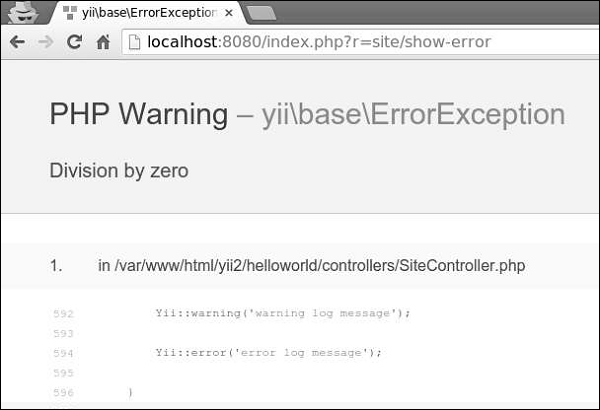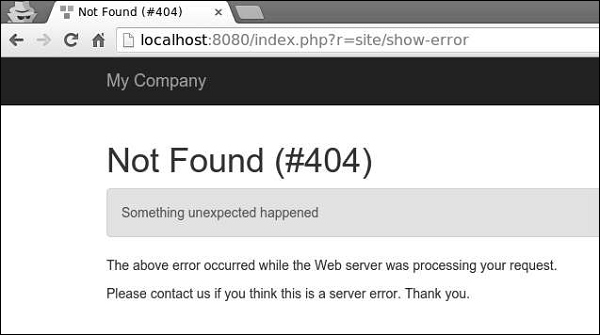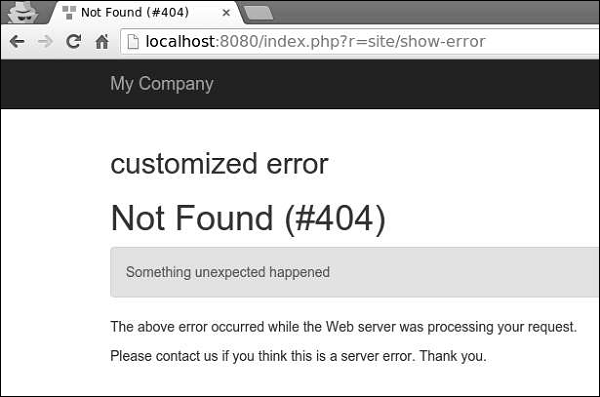
- Yii - Home
- Yii - Overview
- Yii - Installation
- Yii - Create Page
- Yii - Application Structure
- Yii - Entry Scripts
- Yii - Controllers
- Yii - Using Controllers
- Yii - Using Actions
- Yii - Models
- Yii - Widgets
- Yii - Modules
- Yii - Views
- Yii - Layouts
- Yii - Assets
- Yii - Asset Conversion
- Yii - Extensions
- Yii - Creating Extensions
- Yii - HTTP Requests
- Yii - Responses
- Yii - URL Formats
- Yii - URL Routing
- Yii - Rules of URL
- Yii - HTML Forms
- Yii - Validation
- Yii - Ad Hoc Validation
- Yii - AJAX Validation
- Yii - Sessions
- Yii - Using Flash Data
- Yii - Cookies
- Yii - Using Cookies
- Yii - Files Upload
- Yii - Formatting
- Yii - Pagination
- Yii - Sorting
- Yii - Properties
- Yii - Data Providers
- Yii - Data Widgets
- Yii - ListView Widget
- Yii - GridView Widget
- Yii - Events
- Yii - Creating Event
- Yii - Behaviors
- Yii - Creating a Behavior
- Yii - Configurations
- Yii - Dependency Injection
- Yii - Database Access
- Yii - Data Access Objects
- Yii - Query Builder
- Yii - Active Record
- Yii - Database Migration
- Yii - Theming
- Yii - RESTful APIs
- Yii - RESTful APIs in Action
- Yii - Fields
- Yii - Testing
- Yii - Caching
- Yii - Fragment Caching
- Yii - Aliases
- Yii - Logging
- Yii - Error Handling
- Yii - Authentication
- Yii - Authorization
- Yii - Localization
- Yii - Gii
- Gii – Creating a Model
- Gii – Generating Controller
- Gii – Generating Module
Yii - Error Handling
Yii includes a built-in error handler. The Yii error handler does the following −
- Converts all non-fatal PHP errors into catchable exceptions.
- Displays all errors and exceptions with a detailed call stack.
- Supports different error formats.
- Supports using a controller action to display errors.
To disable the error handler, you should define the YII_ENABLE_ERROR_HANDLER constant to be false in the entry script. The error handler is registered as an application component.
Step 1 − You can configure it in the following way.
return [
'components' => [
'errorHandler' => [
'maxSourceLines' => 10,
],
],
];
The above configuration sets the number of source code lines to be displayed to 10. The error handler converts all non-fatal PHP errors into catchable exceptions.
Step 2 − Add a new function called actionShowError() to the SiteController.
public function actionShowError() {
try {
5/0;
} catch (ErrorException $e) {
Yii::warning("Ooops...division by zero.");
}
// execution continues...
}
Step 3 − Go to the URL http://localhost:8080/index.php?r=site/show-error. You will see a warning message.

If you want to show the user that his request is invalid, you may throw the yii\web\NotFoundHttpException.
Step 4 − Modify the actionShowError() function.
public function actionShowError() {
throw new NotFoundHttpException("Something unexpected happened");
}
Step 5 − Type the address http://localhost:8080/index.php?r=site/show-error in the address bar. You will see the following HTTP error.

When the YII_DEBUG constant is true, the error handler will display errors with a detailed call stack. When the constant is false, only the error message will be displayed. By default, the error handler shows errors using these views −
@yii/views/errorHandler/exception.php − the view file is used when errors should be displayed with call stack information.
@yii/views/errorHandler/error.php − the view file is used when errors should be displayed without call stack information.
You can use dedicated error actions to customize the error display.
Step 6 − Modify the errorHandler application component in the config/web.php file.
<?php
$params = require(__DIR__ . '/params.php');
$config = [
'id' => 'basic',
'basePath' => dirname(__DIR__),
'bootstrap' => ['log'],
'components' => [
'request' => [
// !!! insert a secret key in the following (if it is empty) - this
//is required by cookie validation
'cookieValidationKey' => 'ymoaYrebZHa8gURuolioHGlK8fLXCKjO',
],
'cache' => [
'class' => 'yii\caching\FileCache',
],
'user' => [
'identityClass' => 'app\models\User',
'enableAutoLogin' => true,
],
'errorHandler' => [
'errorAction' => 'site/error',
],
//other components...
'db' => require(__DIR__ . '/db.php'),
],
'modules' => [
'hello' => [
'class' => 'app\modules\hello\Hello',
],
],
'params' => $params,
];
if (YII_ENV_DEV) {
// configuration adjustments for 'dev' environment
$config['bootstrap'][] = 'debug';
$config['modules']['debug'] = [
'class' => 'yii\debug\Module',
];
$config['bootstrap'][] = 'gii';
$config['modules']['gii'] = [
'class' => 'yii\gii\Module',
];
}
return $config;
?>
The above configuration defines that when an error needs to be displayed without the call stack, the site/error action will be executed.
Step 7 − Modify the actions() method of the SiteController.
public function actions() {
return [
'error' => [
'class' => 'yii\web\ErrorAction',
],
];
}
The above code defines, that when an error occurs, the error view will be rendered.
Step 8 − Create a file called error.php under the views/site directory.
<?php
/* @var $this yii\web\View */
/* @var $name string */
/* @var $message string */
/* @var $exception Exception */
use yii\helpers\Html;
$this->title = $name;
?>
<div class = "site-error">
<h2>customized error</h2>
<h1><?= Html::encode($this->title) ?></h1>
<div class = "alert alert-danger">
<?= nl2br(Html::encode($message)) ?>
</div>
<p>
The above error occurred while the Web server was processing your request.
</p>
<p>
Please contact us if you think this is a server error. Thank you.
</p>
</div>
Step 9 − Go to the address http://localhost:8080/index.php?r=site/show-error, you will see the customized error view.
